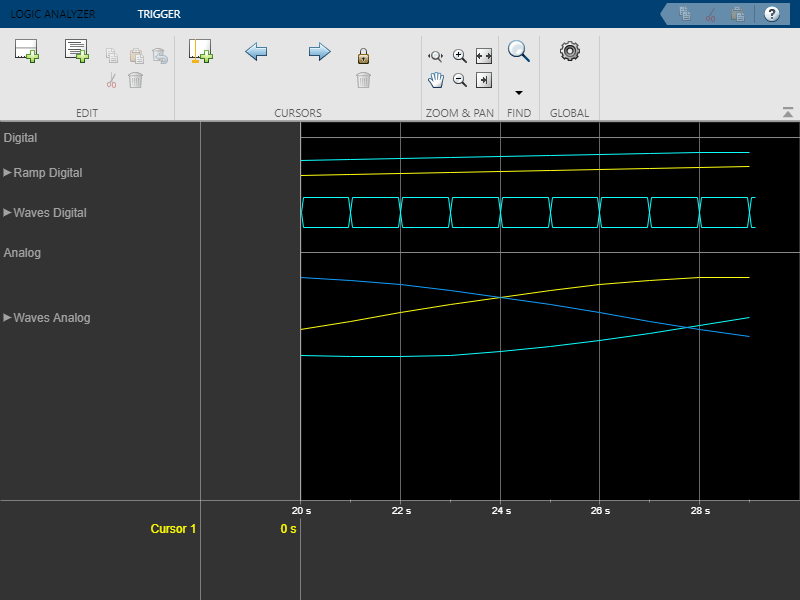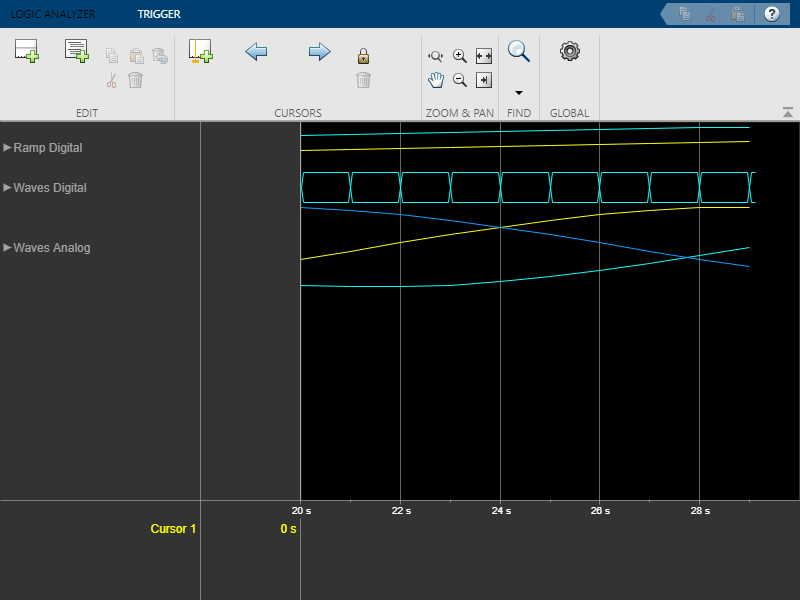addWave
Add wave to Logic Analyzer
Description
Examples
Use functions to construct and manipulate a dsp.LogicAnalyzer System object.
Display Waves on Logic Analyzer scope.
scope = dsp.LogicAnalyzer('NumInputPorts',2); stop = 30; for count = 1:stop sinValVec = sin(count/stop*2*pi); cosValVec = cos(count/stop*2*pi); cosValVecOffset = cos((count+10)/stop*2*pi); scope([count (count-(stop/2))],[sinValVec cosValVec cosValVecOffset]) end

Reorganize Display
hide(scope) digitalDividerTag = addDivider(scope,'Name','Digital','Height',20); analogDividerTag = addDivider(scope,'Name','Analog','Height',40); tags = getDisplayChannelTags(scope); modifyDisplayChannel(scope,tags{1},'InputChannel',1,... 'Name','Ramp Digital','Height',40); modifyDisplayChannel(scope,tags{2},'InputChannel',2,... 'Name','Waves Analog','Format','Analog','Height',80); moveDisplayChannel(scope,digitalDividerTag,'DisplayChannel',1) moveDisplayChannel(scope,tags{2},'DisplayChannel',length(tags)) show(scope)

Duplicate Wave and Check Information
hide(scope) addWave(scope,'InputChannel',2,'Name','Waves Digital','Format','Digital',... 'Height',30,'DisplayChannel',3); show(scope)

Remove Dividers
hide(scope) deleteDisplayChannel(scope,digitalDividerTag) deleteDisplayChannel(scope,analogDividerTag) show(scope)

Clear variables
clear analogDividerTag cosValVec cosValVecOffset count digitalDividerTag duplicateWave scope sinValVec stop tags
Input Arguments
Example: 'addWave(scope)' adds a wave with the default characteristics.
Name-Value Arguments
Specify optional pairs of arguments as
Name1=Value1,...,NameN=ValueN, where Name is
the argument name and Value is the corresponding value.
Name-value arguments must appear after other arguments, but the order of the
pairs does not matter.
Before R2021a, use commas to separate each name and value, and enclose
Name in quotes.
Example: 'InputChannel',2,'Color','Blue' specifies that a wave should be added to input channel 1 and
colored blue.
Color of the wave, specified as an [R G B] value or one of the following:
'Black''Blue''Cyan''Default''Green''Magenta''Red''White''Yellow'
When you choose 'Default', the value of the DisplayChannelColor
property in the Logic Analyzer is used.
Example: 'Color','Blue'
Example: 'Color',[0,0,1]
Data Types: char | string | double | single | uint8 | uint16 | uint32 | uint64 | int8 | int16 | int32 | int64
Specify as a scalar numeric value the display channel that shows this wave. By default, the wave is added to the end of the display.
Example: 'DisplayChannel',2
Data Types: double | single | uint8 | uint16 | uint32 | uint64 | int8 | int16 | int32 | int64
Specify as a scalar nonnegative integer the font size in points. When you choose 0, the value of the
DisplayChannelFontSize property in the Logic Analyzer is used.
Example: 'FontSize',8
Data Types: double
When you choose 'Default', the value of the DisplayChannelFormat
property in the Logic Analyzer is used.
Example: 'Format','Digital'
Data Types: char | string
Specify as a scalar integer the height of the wave in the display in units of
16 pixels. When you choose 0, the value of the
DisplayChannelHeight property in the Logic Analyzer is
used.
Example: 'Height',2
Data Types: double
This property specifies the input channel whose data is used for this wave. By default, it will connect the first input to this wave.
Example: 'InputChannel',2
Data Types: double | single | uint8 | uint16 | uint32 | uint64 | int8 | int16 | int32 | int64
Specify the name that you would like to set for the new wave.
Example: 'Name','MyWave'
Data Types: char | string
When the input signals are of class double, single, or logical, you should not set this property. When you
choose 'Default', the value of the DisplayChannelRadix property in the
Logic Analyzer is used.
Data Types: char | string
Output Arguments
A tag for the newly added wave. Use the tag name to modify and delete the wave.
Version History
Introduced in R2013a
MATLAB Command
You clicked a link that corresponds to this MATLAB command:
Run the command by entering it in the MATLAB Command Window. Web browsers do not support MATLAB commands.
选择网站
选择网站以获取翻译的可用内容,以及查看当地活动和优惠。根据您的位置,我们建议您选择:。
您也可以从以下列表中选择网站:
如何获得最佳网站性能
选择中国网站(中文或英文)以获得最佳网站性能。其他 MathWorks 国家/地区网站并未针对您所在位置的访问进行优化。
美洲
- América Latina (Español)
- Canada (English)
- United States (English)
欧洲
- Belgium (English)
- Denmark (English)
- Deutschland (Deutsch)
- España (Español)
- Finland (English)
- France (Français)
- Ireland (English)
- Italia (Italiano)
- Luxembourg (English)
- Netherlands (English)
- Norway (English)
- Österreich (Deutsch)
- Portugal (English)
- Sweden (English)
- Switzerland
- United Kingdom (English)